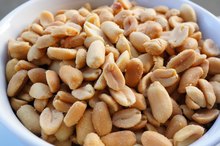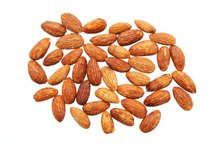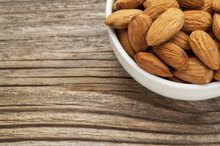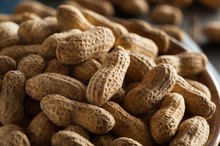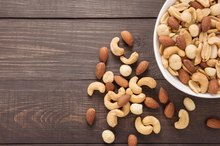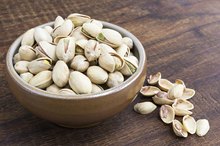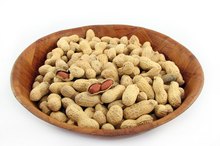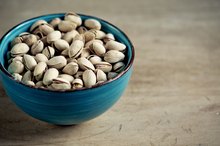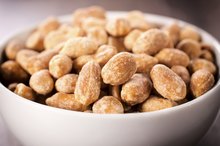Nuts & Their Negative Effects
Because of their high fat and calorie content, nuts can pose a hazard to your waistline if eaten to excess, and if you suffer from a nut allergy, you need to steer clear of them altogether. However, if eaten in moderation as part of a balanced diet, the health benefits of nuts far outweigh their drawbacks for most people 1.
In a Nutshell
The U.S. Department of Agriculture notes that regular nut consumption has been associated with lower cholesterol and blood pressure levels and reduced risk of heart disease.
Little Snack, Big Fat
Side Effects of Eating Nuts
Learn More
Nuts have a high fat content, so maintain a daily intake of 1.5 ounces, or one-quarter cup, if you don't want them going to your hips. Nevertheless, the fats they contain are healthy unsaturated fats. Because they are so dense in fat, protein and fiber, a diet that includes nuts can curb hunger and make you less likely to fill up on an unhealthy snack.
Watch Those Calories
If you lead a somewhat sedentary life, the high calorie content of nuts can be a concern. Try pistachios, which have fewer calories per pound than other nuts and provide the typical benefits to your heart, cholesterol level and blood pressure.
Beware of Allergies
The Nutrition of Smoked Almonds
Learn More
Nuts are on the list of the eight most common food allergens, which cause 90 percent of allergies. In severe cases, an allergic nut reaction can take the form of anaphylactic shock, where the blood pressure drops suddenly, resulting in unconsciousness. Nuts shouldn't be given to infants under 8 months old, as this can help trigger the allergy, and if you or your partner is allergic, keep your child away from nuts until he is at least 3 years old.
Related Articles
References
- USDA Center for Nutrition Policy and Promotion: The Role of Nuts in a Healthy Diet
- Superfoods; Stephen G. Pratt and Kathy Matthews
- The Complete Book of Natural Pregnancy and Childcare; Anne Charlish and Kim Davies
- Cleveland Clinic. Fat and calories. Updated April 2019.
- Slavin J, Carlson J. Carbohydrates. Adv Nutr. 2014;(5)6:760-1. doi:10.3945/an.114.006163
- US Department of Agriculture. FoodData Central.
- Liu AG, Ford NA, Hu FB, Zelman KM, Mozaffarian D, Kris-etherton PM. A healthy approach to dietary fats: understanding the science and taking action to reduce consumer confusion. Nutr J. 2017;(16)1:53. doi:10.1186/s12937-017-0271-4
- Hever J, Cronise RJ. Plant-based nutrition for healthcare professionals: implementing diet as a primary modality in the prevention and treatment of chronic disease. J Geriatr Cardiol. 2017;(14)5:355-368. doi:10.11909/j.issn.1671-5411.2017.05.012
- Gupta RK, Gangoliya SS, Singh NK. Reduction of phytic acid and enhancement of bioavailable micronutrients in food grains. J Food Sci Technol. 2015;(52)2:676-84. doi:10.1007/s13197-013-0978-y
- Wang TY, Liu M, Portincasa P, Wang DQ. New insights into the molecular mechanism of intestinal fatty acid absorption. Eur J Clin Invest. 2013;(43)11:1203-23. doi:10.1111/eci.12161
- US National Library of Medicine. Soluble vs. insoluble fiber. Updated June 2018.
- Academy of Nutrition and Dietetics. Gluten free diet: building the grocery list. November 2018.
- Harvard Medical School. Quick-start guide to nuts and seeds. September 2019.
- Zhivagui M, Ng AWT, Ardin M, et al. Experimental and pan-cancer genome analyses reveal widespread contribution of acrylamide exposure to carcinogenesis in humans. Genome Res. 2019;(29)4:521-531. doi:10.1101/gr.242453.118
- Iweala OI, Choudhary SK, Commins SP. Food Allergy. Curr Gastroenterol Rep. 2018;(20)5:17. doi:10.1007/s11894-018-0624-y
- American College of Allergy, Asthma, and Immunology (ACAAI). Newly Issued Clinical Guidelines from the NIAID Recommend the Early Peanut Introduction, Not Avoidance. Milwaukie, Wisconsin; press release issued January 5, 2017.
- Du Toit. G.; Roberts, G.; Sayer, P. et al. Randomized Trial of Peanut Consumption in Infants at Risk for Peanut Allergy. N Engl J Med. 2015; 372:803-13. DOI: 10.1056/NEJMoa1414850.
- McMacken M, Shah S. A plant-based diet for the prevention and treatment of type 2 diabetes. Journal of Geriatric Cardiology : JGC. 2017;14(5):342-354. DOI: 10.11909/j.issn.1671-5411.2017.05.009.
- Tuso PJ, Ismail MH, Ha BP, Bartolotto C. Nutritional update for physicians: plant-based diets. Perm J. 2013;17(2):61-6. DOI: 10.7812/TPP/12-085.
- Wright, N., Wilson, L., Smith, M., Duncan, B., & McHugh, P. (2017). The BROAD study: A randomised controlled trial using a whole food plant-based diet in the community for obesity, ischaemic heart disease or diabetes. Nutrition & Diabetes, 7(3), e256–e256. DOI: 10.1038/nutd.2017.3.
- Preedy, V.; Watson, R.; and Patel, V. (2011) Nuts and Seeds in Health and Disease Prevention (1st Edition). New York: Academic Press. ISBN: 9780123756886.
Writer Bio
Based in the United Kingdom, Graham Rix has been writing on the arts, antiquing and other enthusiasms since 1987. He has been published in “The Observer” and “Cosmopolitan.” Rix holds a Master of Arts degree in English from Magdalen College, Oxford.
